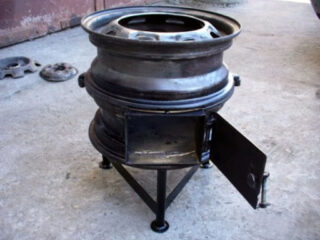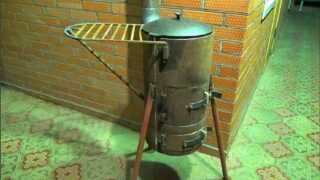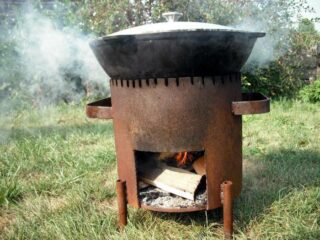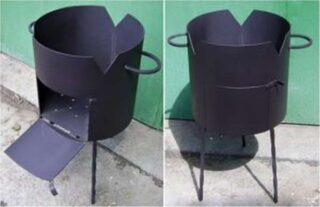When cooking pilaf and other dishes in a cauldron, food languishes for a long time in a gradually decreasing temperature. This method allows you to get food with a barely noticeable "smoke". A metal stove for a cauldron with your own hands is easy to make from the raw materials available at hand.
What is a cauldron

A cauldron is a container made of cast iron or aluminum, the bottom area of which has the shape of a hemisphere. This structure allows you to lower the boiler directly into the hearth, achieving uniform heating of the contents. You can cook food in a small cauldron in the house on the stove using a stand. For large containers over 10 liters, an outdoor oven is required. You can make the structure stationary or move from place to place. An old worn-out metal stove can be bricked.
The thickness of the cauldron walls depends on the material used. If lightweight aluminum is used, they are made thick (about 1 cm). The cast iron product can be made thin-walled (3-4 mm).
Features and types of ovens for the cauldron
The stove under the cauldron is laid out of refractory bricks or mounted from metal. The second option is faster in execution, moreover, it allows you to make the design portable. There are several simple ways to make a stove from the metal parts at hand. Multifunctional complexes are often built from bricks, including a brazier, a smokehouse and other devices.
From pipe scraps
To make such a stove under a cauldron, you need several pieces of pipes. The diameter of the fragment from which the furnace body will be created is selected so that the cauldron can be immersed in the structure by 2/3 of its depth. You can find out the circumference by measuring the girth of the boiler at the appropriate height. You will also need a chimney pipe. It will be smaller (about 11 cm in diameter). Supports and handles are made of metal profiles, the bottom of the structure is made of a piece of steel sheet.
From a gas cylinder

The principle of creating a structure from a gas cylinder is similar to that when creating a furnace from a pipe. Some schemes suggest cutting out rectangular elements at the top of the structure to fix the boiler at the desired height. Gaps between them provide smoke escape. The advantage of this design is the thickness of the walls: due to this, it can last a long time. The furnaces of such stoves are often not equipped with doors. Air intake is regulated by partial closing of the furnace lumen. Since the lower part of the cylinder is sufficiently stable, the structure may not be provided with legs.
Rims
You can also make a structure from the rims of a passenger car. Only stamped steel elements are suitable for it. Cast aluminum wheels will not work - they wear out quickly due to their sensitivity to high temperatures. For the structure, elements of the same size are selected to get a structure resembling a barrel or pipe. Mount the top disc so that the side of the fastener is on top. The boiler will need to be placed there. The hole is cut in accordance with the dimensions. The disk, which serves as the bottom, is mounted with the fastening side down. For the combustion chamber, a rectangular-shaped hole is cut in it.
From a sheet of metal
As with most other options, welding skills are required.Having determined the circumference at the point denoting 2/3 of the cauldron height from the bottom, add another 3-4 mm to this number as a seam allowance. The smoke escape is provided by the slots between the teeth in the upper part. A hole for the firebox is also cut in the sheet. After that, the structure is rolled up into a cylinder and welded along the entire joint line. You can place the oven directly on the ground or on a prepared base.
Shape and size

Most often, furnaces are either cylindrical or made in the form of a polygonal prism. The first option is difficult to implement in the absence of rollers (it will be uneven), but a round stand for the cauldron is not required. When creating such a furnace, it is important to choose the correct structure diameter. It is advisable to make it for an already existing cauldron, and not purchase a boiler for a finished furnace. The rectangular prism is easy to assemble, but requires a stand with a round hole for the container.
The stove can be equipped with or without a chimney. A vent is usually created to reduce fumes around the boiler. The pipe must be of sufficient height.
Making a furnace for a cauldron from sheet steel
An iron sheet with a thickness of 3 mm is required. It is not recommended to take a thinner sheet - it can deform unnecessarily during work and wear out from the regular action of high temperatures. In addition, it is easier for a person with little experience to work with thicker steel. You will also need to prepare an apparatus for welding, suitable electrodes for it and a grinder for cutting and stripping structural elements. An electric drill and drills of different diameters are also needed.
First, you need to create a cylinder from a sheet blank. Without rollers, this can be done by welding the side of the fragment to the mandrel of the required dimensions. The structure is heated and tapped with a hammer. Another way is to gradually bend to a small angle. If the furnace is rectangular, the sides are welded from the same parts. The width will then be 10 cm greater than the diameter of the boiler. A cutout for the door is made at the bottom. Its dimensions are 20x30 cm. A slot for the chimney pipe is made at a height of 5-10 cm from the top, on the opposite side of the door.

In the future, the sequence of actions looks like this:
- The blank for the furnace bottom is cut to the required dimensions. In front, it should protrude by 0.1-0.15 m.
- If the stove is made quadrangular, you need to prepare the upper support according to the diameter of the cauldron and weld it.
- A door is created and mounted. It requires a piece of sheet that is 2 cm larger in size (height and width) than the parameters of the hole. You cannot take the piece obtained when creating the latter - the result will not be neat. In the lower part, several holes with a diameter of 1.5-2 cm are made in a row. The hinges for the door are made of reinforcement fragments, nuts and other parts. You also need to make a latch for it.
- Two handles from a rod can be welded to the stove. This will make it easier to carry from place to place.
- Support legs are made from corners and are bolted to the bottom of the furnace. Their length is chosen so that it is convenient for the cook to stir the food.
- Then the chimney is welded in. Its height can be 1.3-1.5 m. If it is decided not to make a chimney, serrated or petal elements are created in the upper part. Excess smoke will escape through the slots between them.
When the structure is ready, the final finishing is done. The seams are cleaned, the notches hit. Then, rust must be removed from the surface. For painting, a special composition for steel furnaces is suitable.
Features of creating a furnace from a metal pipe

For such a design, an ordinary water pipe is suitable, provided that it is possible to find a product with a diameter corresponding to the dimensions of the cauldron. A segment half a meter long is separated from it. For the chimney, a narrower pipe (0.1 m in diameter) with a length of 1.5 m is needed. For the bottom, a sheet of steel with a thickness of 4 mm is taken.The fixing method for this element is the same as for a sheet metal oven. A hole for the door must be cut in the pipe. The latter is best done from a piece of sheet steel. They fasten it on hinges, and a metal rod is used to fix it in the closed position. The installation method for the carrying handles and support feet is the same as for the sheet steel version. You can make a groove in the structure with a box for the accumulation of coals so that the latter do not fall out.
Do not start cooking on a chimney stove immediately after assembly. First you need to clean the walls of oil. They are washed from the inside using a special stiff metal brush. After the structure has completely dried out, the first laying of firewood is made. It is required to bake the pipe well and remove fuel residues from the inside. Then you can add firewood for cooking.








